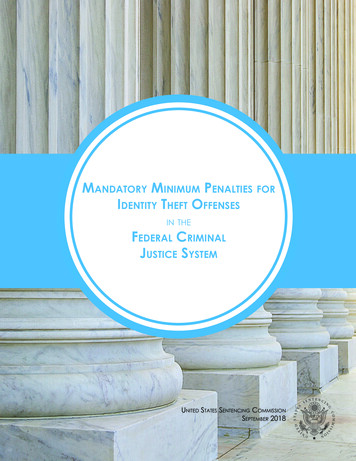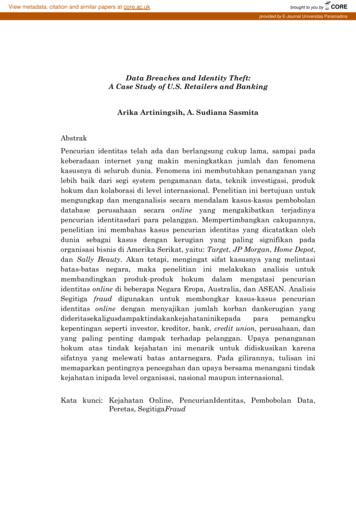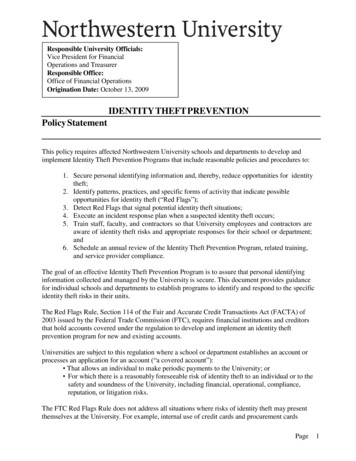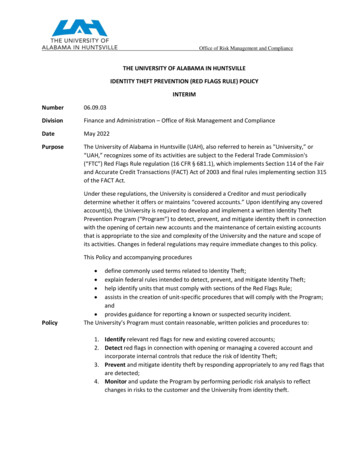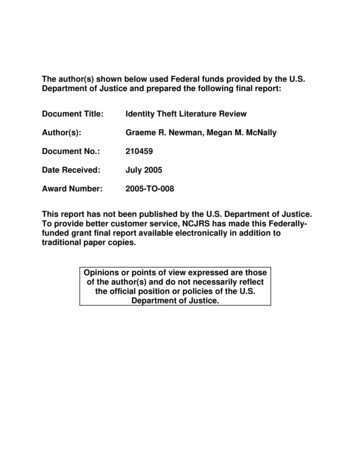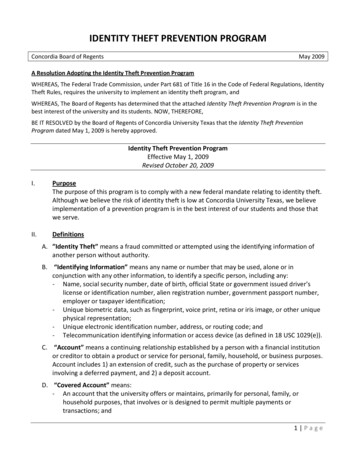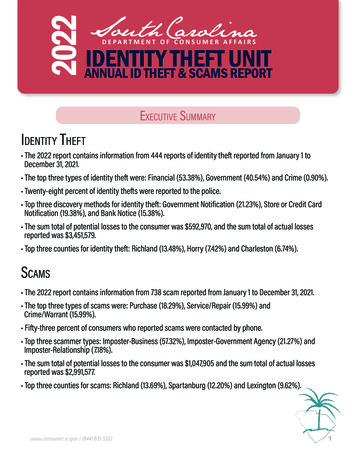
Transcription
Canadian Internet Policy and Public Interest ClinicClinique d’intérêt public et de politique d’internet du CanadaIDENTITY THEFT:INTRODUCTION ANDBACKGROUNDMarch, 2007CIPPIC Working Paper No. 1 (ID Theft Series)www.cippic.ca
CIPPIC Identity Theft Working Paper SeriesThis series of working papers, researched in 2006, is designed to provide relevant anduseful information to public and private sector organizations struggling with the growingproblem of identity theft and fraud. It is funded by a grant from the Ontario ResearchNetwork on Electronic Commerce (ORNEC), a consortium of private sectororganizations, government agencies, and academic institutions. These working papersare part of a broader ORNEC research project on identity theft, involving researchersfrom multiple disciplines and four post-secondary institutions. For more information onthe ORNEC project, see www.ornec.ca .Senior Researcher: Wendy ParkesResearch Assistant: Thomas LegaultProject Director: Philippa LawsonSuggested Citation:CIPPIC (2007), "Identity Theft: Introduction and Background", CIPPIC Working PaperNo.1 (ID Theft Series), March 2007, Ottawa: Canadian Internet Policy and PublicInterest Clinic.Working Paper Series:No.1: Identity Theft: Introduction and BackgroundNo.2: Techniques of Identity TheftNo.3: Legislative Approaches to Identity TheftNo.3A: Canadian Legislation Relevant to Identity Theft: Annotated ReviewNo.3B: United States Legislation Relevant to Identity Theft: Annotated ReviewNo.3C: Australian, French, and U.K. Legislation Relevant to Identity Theft: AnnotatedReviewNo.4: Caselaw on Identity TheftNo.5: Enforcement of Identity Theft LawsNo.6: Policy Approaches to Identity TheftNo.7: Identity Theft: BibliographyCIPPICThe Canadian Internet Policy and Public Interest Clinic (CIPPIC) was established at theFaculty of Law, University of Ottawa, in 2003. CIPPIC's mission is to fill voids in lawand public policy formation on issues arising from the use of new technologies. Theclinic provides undergraduate and graduate law students with a hands-on educationalexperience in public interest research and advocacy, while fulfilling its mission ofcontributing effectively to the development of law and policy on emerging issues.Canadian Internet Policy and Public Interest Clinic (CIPPIC)University of Ottawa, Faculty of Law57 Louis Pasteur, Ottawa, ON K1N 6N5tel: 613-562-5800 x2553fax: 613-562-5417www.cippic.ca
EXECUTIVE SUMMARYThis Working Paper provides background information on the history, characteristics,causes and extent of identity theft. It discusses the challenges of defining the term“identity theft” and of measuring its size and impacts. It identifies key stakeholders andanalyzes the impact of technology, including the widespread use of the internet, onidentity theft.NOTE RE TERMINOLOGYThe term “identity theft”, as used in this Working Paper series, refers broadly to thecombination of unauthorized collection and fraudulent use of someone else’s personalinformation. It thus encompasses a number of activities, including collection of personalinformation (which may or may not be undertaken in an illegal manner), creation of falseidentity documents, and fraudulent use of the personal information. Many commentatorshave pointed out that the term “identity theft” is commonly used to mean “identityfraud”, and that the concepts of “theft” and “fraud” should be separated. While we haveattempted to separate these concepts, we use the term “identity theft” in the broader sensedescribed above. The issue of terminology is discussed further in this first paper of theID Theft Working Paper series.
TABLE OF CONTENTSPageINTRODUCTION . 1TERMINOLOGY. 1THE SIGNIFICANCE OF IDENTITY THEFT. 3HOW BIG IS THE PROBLEM? . 4OBJECTIVES OF THE WORKING PAPERS. 6IDENTITY THEFT STAKEHOLDERS. 7CHARACTERISTICS AND UNDERLYING CAUSES OF IDENTITY THEFT . 9ADVANCES IN TECHNOLOGY: CONSEQUENCES FOR IDENTITY THEFT. 11CONCLUSIONS. 14APPENDIX A – DEFINITIONS . 15RELATED DEFINITIONS. 15PUBLISHED DEFINITIONS. 15Government Agencies . 15Periodicals . 17Trade Associations. 18Consumer Associations. 19Law Enforcement agencies . 20Canada . 20United States . 21Definitions from other organisations. 21
1
CIPPIC Working Paper No.1Identity Theft: Introduction and BackgrounderINTRODUCTIONTwenty years ago, the term “identity theft” was little used and little known. Today, it is awidely recognized term, one associated with a phenomenon that has captured public,media and government attention and which has become a serious social issue. Oftendescribed in alarming terms – “the crime of the new millennium”,1 the “nightmare ofidentity theft”2, the “quintessential crime of the information age”3, identity theft hasbecome one of the most prevalent types of white collar crime. Its impacts can befinancially devastating and personally traumatic, its effects long lasting. These can extendnot only to individual victims, but also to governments, businesses and society in general.TERMINOLOGYWhat exactly is identity theft? Is it possible to develop an accurate and commonlyapplicable definition? At first glance, this would seem to be a relatively easy task. Inreality, the challenge is formidable. One author has described this problem in thefollowing way:Confusion about (the definition of) identity theft is growing at a faster ratethan the actual incidence of the crime, clouding the true causes andconsequences to individuals and enterprises.4The list of definitions in Appendix A illustrates this point. Although they share manysimilar features, none of these definitions are identical.Identity theft occurs when the personal identifying information of an individual ismisappropriated and used in order to gain some advantage, usually financial, bydeception.5 It can take many forms.At one end of the spectrum is fraudulent use of another person’s account information(e.g., credit card number) in order to make unauthorized financial transactions, withoutany additional attempts to impersonate that other person. Such fraud has been addressedwith varying degrees of effectiveness by legislators and the private sector. These types ofactivities are classified by the financial industry as payment card fraud, rather thanidentity theft. However, they tend to be regarded in the public eye as identity theft (aphenomenon that has been called “definition creep”).61Sean B. Hoar, “Identity Theft: The Crime of the New Millennium” (2001) 80 Oregon L at 1423.Joe Vanden Plas, “Managing the nightmare of identity theft”, Wisconsin Technology Network (5September 2006) at 1, online: http://wistechnology.com/article.php?id 2942 .3Charles M. Kahn & William Roberds, “Credit and Identity Theft” (August 2005) Federal Review Bank ofAtlanta Working Paper Series, Working Paper 2005-19 at 1.4Lombardi, Rosie, Myths about identity theft debunked by experts, IT World Canada (22 March 2006).5B.C. Freedom of Information and Privacy Association, PIPEDA and Identity Theft: Solutions forProtecting Canadians, (30 April 2005) at 6.6Lombardi, supra note 4.21
CIPPIC Working Paper No.1Identity Theft: Introduction and BackgrounderIt can be difficult to distinguish between ordinary fraud and that which is truly “identitytheft”. In the case of true “identity theft”, the thief misappropriates information relating tothe identity of a person - information such as name, address, telephone number, date ofbirth, mother’s maiden name, Social Insurance Number (SIN), driver’s licence number,or health card number and then masquerades as the victim, effectively taking over theiridentity.The thief may then go on to conduct financial transactions in the name of the oftenunsuspecting victim, including opening bank, utility and cell phone accounts, securingcredit cards, obtaining benefits, securing employment, committing crimes or evenbeginning a new life, often in other countries.7 In some instances, blackmail, terrorism,money laundering, people smuggling, immigration scams or drug related crimes may becommitted, or the stolen identity may be used by known criminals to hide from lawenforcement agencies. The victim’s email account may be used to send threatening ordefamatory messages. This is different from simply using personal account information,such as a credit card number, to make unauthorized transactions.8A useful definitional model of identity theft has been proposed by Sproule and Archer.9Identity theft encompasses the collection of personal information and the development offalse identities. Identity fraud refers to the use of a false identity to commit fraud.Figure 1 - Definitional Model of Identity Theft7Wenjie Wang, Yufei Yuan & Norm Archer “A Contextual Framework for Combating Identity Theft”(March/April 2006) IEEE Security & Privacy at 25.8Lombardi, supra note 4.9Susan Sproule and Norm Archer, Defining and Measuring Identity Theft, presentation to the secondOntario Research Network in Electronic Commerce (ORNEC) Identity Theft Workshop, (Ottawa, 13October 2006).2
CIPPIC Working Paper No.1Identity Theft: Introduction and BackgrounderDrawing from this model, and for the purposes these Working Papers, identity theft isdefined as a process involving two stages: 1) the unauthorized collection of personalinformation; and 2) the fraudulent use of that personal information to gain advantage atthe expense of the individual to which the information belongs:1) Unauthorized Collection: Identity theft starts with the misappropriation of a livingor dead individual’s personal information, without consent and often withoutknowledge, or by theft, fraud or deception. The information can be usedimmediately, stored for later use or transmitted for use by someone else.2) Fraudulent Use: Identity theft continues with the fraudulent use of the personalinformation, typically for economic gain. The perpetrator impersonates the victimin order to obtain credit or other benefits in their name. A hallmark of identitytheft is repeat victimization - the thief will usually engage in a series of fraudulentuses.10We use the term "identity theft" to cover both the initial unauthorized collection ofpersonal information, and the later fraudulent use of that information.THE SIGNIFICANCE OF IDENTITY THEFTWhy has identity theft become such a gripping issue, compared with other types ofcrime? Any form of crime has negative financial and other consequences for its victims,but those associated with identity theft can be particularly hard hitting. Someone’sidentity is unique and highly personal. To have one’s identity informationmisappropriated by another is a privacy violation of the highest order, akin to and evenmore invasive than the theft of personal property resulting from a home break-in.The financial cost of identity theft may be significant. Using the misappropriatedpersonal information of an individual, a thief can make financial transactions as thatperson, emptying bank accounts, making purchases and racking up debts. It may be sometime before the victim realizes what has happened.However, the effects of identity theft may go far beyond financial loss. Victims oftraditional theft can usually replace their possessions, but a victim of identity theft maysuffer loss of reputation and standing in the community, as well as damage to their creditrating.11 It may take considerable time and expense to resolve the resulting problems. Atworst, the effects of identity theft may linger, haunting victims indefinitely. Long afterthe event, they may find themselves denied credit, or even arrested for crimes committedby the identity thief.10U.S. Department of Justice, Identity Theft, Problem-Oriented Guides for Police, Problem-SpecificGuides Series, No. 25 (June 2004) at 1, online: http://www.cops.usdoj.gov/mime/open.pdf?Item 1271.11Bill Diedrich, “Chapter 254: Closing the Loopholes on Identity Theft, But at What Cost?” (2005) 34McGeorge Law Review at 383.3
CIPPIC Working Paper No.1Identity Theft: Introduction and BackgrounderIdentity theft is not just a problem in its own right. It also has ramifications for othertypes of crime. United States and Canadian law enforcement agencies report a growingtrend in both countries toward greater use of identity theft as a means of furthering orfacilitating other forms of fraud, organized crime (the bulk of identity crime is committedby organized crime) and terrorism.12 Especially troubling is the now established linkbetween identity theft and national security.Although rates of identity theft are levelling off, a significant percentage of Canadiansfeel threatened. A poll conducted in February, 2006 found that 71% of Canadians arevery or somewhat concerned about becoming a victim of identity theft in the future. Italso found that 4% of Canadians have personally been subject to identity theft and 20%know someone who has been affected. The number of victims increases to 8% whenlooking only at credit card holders.13Governments in Canada, the U.S. and in other countries have taken action to combatwhat has become a crime of international dimensions. Public awareness and victimassistance programs have grown. In spite of new laws, policies and practices, however,identity theft continues to challenge the best efforts of governments, law enforcement, thecorporate sector and individual citizens.HOW BIG IS THE PROBLEM?Until the last few years, occurrences of identity theft were on the rise. Recently, the rateof increase started to level off, in both Canada and the U.S.In Canada, Equifax and TransUnion (the two largest Canadian credit bureaus), receiveapproximately 1400 to 1800 complaints of identity theft per month.14 PhoneBusters, anorganization which studies and reports on identity theft, collects data, educates the public,and assists both Canadian and U.S. law enforcement agencies, reported about 11,000complaints in 2005 (compared with approximately 8,000 in 2002), at a cost of 8.6million (compared to 11.7 million in 2002).15 About one third related to credit cards,including false applications, and 10-12 % related to cell phones.16 In the first ten monthsof 2006, 6,483 victims reported to Phonebusters, a lower rate than for 2005. However, the12Canada, Department of the Solicitor General and U.S. Department of Justice, Public Advisory: SpecialReport for Consumers on Identity Theft (2003). For example, a recent investigation into a case of identitytheft uncovered a major drug operation. The drug traffickers had committed identity theft to rent spacewithin which they operated a clandestine drug lab.13Ipsos-Reid, One-Quarter of Canadian Adults (24%) Have Been Touched by Identity Theft (7 March2006) at 1 - 3.14PIPEDA and Identity Theft, supra note 5 at 10.15Phonebusters, Identity Theft Complaints, online: http://www.phonebusters.com/english/statistics E03.html .16PIPEDA and Identity Theft, supra note 5 at 7.4
CIPPIC Working Paper No.1Identity Theft: Introduction and Backgroundervalue of losses reported for this period was 14,735,882, a higher figure than in previousyears.17The following table illustrates the statistics on the number of Canadian victims and theirlosses for the year 2005.Table 1: 2005 identity Theft Statistics aManitobaNova nd esTotal2005Victims Loss472926142010 4,450,122.62 1,864,574.23 1,376,499.08894361177157127 431,221.89 181,490.32 100,036.04 87,641.63 29,107.528258 4,350.00 43,358.0218 5,907.6331 1,285.00 011231 8,575,593.98Table 1 - Number of victims in Canada (2005)18Identity theft has been called the “fastest-growing crime in the United States”, withapproximately nine million victims annually.19 It has topped the U.S. Federal TradeCommission’s (FTC) list of consumer complaints for the last five years. In 2004, the FTCreceived 246,847 complaints of identity theft, up 52 per cent from 2002. In 2005, 255,565complaints were received, a modest increase. The FTC currently stores about 815,000complaints.2017Phonebusters, Monthly Summary Report, (October 2006), online: http://www.phonebusters.com .PhoneBusters, Identity Theft Complaints, online: http://www.phonebusters.com/english/statistics E05.html .19State of California, Locking up the Evil Twin: a Summit on Identity Theft Solutions, (1 March 2005) at 1.20U.S. Federal Trade Commission, online: http://www.ftc.gov .185
CIPPIC Working Paper No.1Identity Theft: Introduction and BackgrounderIn the five years since it was established by the FBI and the National White Collar CrimeCenter, the Internet Crime Complaint Center (formerly the Internet Fraud ComplaintCenter) has received more than 100,000 complaints related to identity theft. In 2004, itaveraged more than 17,000 consumer complaints monthly.21In January 2006, national researchers noted a levelling off of nationwide victim statistics.However, as in Canada, financial losses have grown, to nearly US57 billion in 2005,indicating a higher per-crime incidence.22According to the FTC, the most common abuses of stolen personal information occurwith credit card, phone or other utility accounts. In 2003, these abuses accounted for 54%of the 214,905 incidents reported. Credit card fraud (33% of all fraud) was the mostcommon form of reported identity theft that year, phone or utility constituted 21%, bankfraud 17% and employment fraud 11%.23What do these statistics mean? How much reliance can be placed on them, given thatthere is no standard definition of identity theft? There can be no question that statisticsare skewed. On the one hand, research has suggested that only about 25 % of victimsreport the crime to the police or to major credit agencies.24 Conversely, individuals mayconsider themselves as victims of identity theft, and report as such to authorities, when infact they are victims of one-time, “everyday” theft or fraud. This creates real problemsfor developing accurate and reliable statistics, and for understanding and dealing with theproblem.These methodological challenges are further complicated by the fact that there isgenerally a lag time between the theft of identifying information and the detection ofdamage. Many victims discover that their identity information has been stolen only whenthey apply for credit or try to get a mortgage, notice withdrawals from their bankaccounts, or receive bills for goods and services that they did not purchase themselves.25On average, there is a one year delay in discovering that identity theft has occurred.26This means that occurrences may be reported only some time after the event. It alsomakes it more difficult to reduce losses and catch and prosecute criminals.OBJECTIVES OF THE WORKING PAPERSWe need to better understand the nature and impacts of this crime. How can identity theftbe prevented and detected? What measures can be taken to assist victims and catch andprosecute criminals?21Ibid.State of California, Teaming up Against Identity Theft, (23 February 2006) at 4.23Locking up the Evil Twin, supra note 19 at 25.24PIPEDA and Identity Theft, supra note 5 at 10.25Police Guide, supra note 10 at 5 and 9.26Federal Trade Commission, National and State Trends in Fraud & Identity Theft January - December2003, (22 January 2004), online: 03.pdf .226
CIPPIC Working Paper No.1Identity Theft: Introduction and BackgrounderWith these questions in mind, this series of Working Papers looks at two dimensions ofidentity theft: law and policy. An effective legal framework, supplemented by wellcrafted policies and practices, are essential parts of the effort to tackle identity theft. Howwell is Canada doing in this regard? How do we compare with the U.S. and othercountries? To date, it appears that no comprehensive survey of Canadian laws andpolicies, one which compares and contrasts the situation here with the U.S. experience,has been undertaken. The objective of this series of Working Papers is to help to fill thisvoid.This first Working Paper provides a foundation for an inventory and analysis of the legaland policy dimensions of identity theft in Canada. The other papers build on thisframework, each exploring a different aspect of the problem: identity theft techniques;existing and proposed laws; court decisions and law enforcement and government andcorporate sector policies aimed at preventing identity theft. A separate White Paper on“Approaches to Security Breach Notification”, released in January 2007, addresses therelated issue of data security breaches.The focus of this paper is on the situation in Canada. However, much of the informationand analysis includes consideration of the U.S. scene. This is in part because, while thesize of the problem is much greater in the U.S., there are many similarities with Canadain terms of the nature and impacts of identity theft. There is also a wealth of information,from media reports, government documents and surveys, and academic literature, onidentity theft that was compiled in U.S. but which reflects, to varying degrees, thesituation in Canada. Third, there has been considerably more activity on the legislativefront in the U.S., where the federal and state governments have been seized by the issueof identity theft and have taken measures to combat it.One underlying premise is that Canada can learn from the experiences of the U.S., and toa lesser degree, from other countries such as the United Kingdom, Australia and France.It is in our interest to see how others have, for better or worse, tackled the problem.IDENTITY THEFT STAKEHOLDERSWhile conducting research on identity theft, it is imperative to keep in mind the mainstakeholders affected by this type of crime. When identity theft crimes are committed, allthe stakeholders identified below are usually involved in some way. The terminologyused reflects the model developed by Wang et al.2727Wang, supra note 7.7
CIPPIC Working Paper No.1Identity Theft: Introduction and BackgrounderIndividualsIndividuals are also known as identity owners.28 They have the legal right to own and usetheir identity. They also have the right to obtain identity certificates such as birthcertificates, passports, driver’s licence and health cards.They are the victims of identity theft who ultimately carry the burden. As noted, identitytheft can be a traumatic experience. Victims suffer financial losses, a loss of reputation,emotional distress, and the often-difficult task of rebuilding their credit rating.29While there are steps individuals can take to protect themselves, the Ontario PrivacyCommissioner has noted that consumers are not in the best position to reduce identitytheft.30 In reality, many consumers are not aware of the collection, use and disclosure oftheir personal information.31 In these circumstances, it is extremely difficult for them toreduce the risk posed by identity theft.GovernmentsGovernments play three roles in the context of identity theft. When individuals apply foridentity certificates, governments play the role of identity certificate issuers.32 By usingappropriate authentication mechanisms when citizens apply for identity certificates,governments play the role of identity information protectors.33 When individuals applyfor benefits offered by the different governmental programs, governments play the role ofidentity verifiers, ensuring that the individual is who they say they are.34Businesses and organizationsBanks, credit card issuers, loan companies, credit bureaus and transaction processingfirms, when providing financial services such as new accounts, loans and mortgages, playthe role of identity checkers. When they provide goods or services or grant credit withoutconducting an appropriate screening of the individual, businesses may facilitate identitytheft. In some instances of identity theft, the perpetrator is an employee of the businessthat collected the information.28Ibid. at 26.Consumer Measures Committee, Working Together to Prevent Identity Theft, (6 July 2005) at 2, online: Consultation%20Workbook IDTheft.pdf/ FILE/Consultation%20Workbook IDTheft.pdf .30Information and Privacy Commissioner of Ontario, Identity Theft Revisited: Security is Not Enough(September 2005) at 4, online: http://www.ipc.on.ca/docs/idtheft-revisit.pdf .31Public Interest Advocacy Centre, Identity Theft: The Need For Better Consumer Protection (November2003) at 30, online: http://www.piac.ca/files/idtheft.pdf .32Wang, supra note 7 at 27.33Ibid.34Ibid.298
CIPPIC Working Paper No.1Identity Theft: Introduction and BackgrounderBusinesses, as well as governments, that collect, hold or transfer personal information,may be subject to security breaches, either internal or external. This is a particularproblem for large data storage businesses.Businesses have a prevention role to play, as identity information protectors. They canfulfill this role by notifying their customers or clients about security breaches and aboutthe risks of identity theft and by offering certain protection packages, such as accountmonitoring.Law Enforcement AgenciesWang has identified law enforcement agencies as also playing a role of identityinformation protectors.35 However, because most investigations occur after identity thefthas been committed, and because prosecution rates for these offences seem low, lawenforcement agencies are better described as "identity information restorers", with policereports and affidavits being used to restore a victim’s credit record and reputation. Incertain situations, such as when law enforcement officials arrest an individual, they playthe role of identity verifiers.CHARACTERISTICS AND UNDERLYING CAUSES OF IDENTITY THEFTIn some respects, identity theft is not a new phenomenon. For hundreds of years, peoplehave claimed to be someone they are not. They have done this for financial gain, to avoidresponsibility for a misdeed, or to gain in social status or an employment position.36Perhaps the most notorious example is that of Frank Abagnale Jr., who for five years inthe 1960s assumed a series of false identities, backed up by false identification. Abagnaledefrauded banks, airlines, hotels and other businesses in 26 countries, for an estimatedtotal of more than 2.5 million.37Although Abagnale apparently created fictitious identities, rather than relying on stolenpersonal information from real people, his reliance on fake identity documents, forgedcheques and social engineering techniques to swindle banks, airlines and otherorganizations was similar to the modus operandi of modern identity thieves. Everydaydocument fraud, cheque swindling and forgery - all components of today’s identity theftphenomenon - have been techniques of choice for criminals for years. Today, however,these crimes have become more complex, often involving many individuals, sophisticatedtechniques and interjurisdictional activity.There is often a network of criminals involved with identity theft. Information obtainedby one set of criminals may be sold to another operative. For example, online “cardernetworks” buy and sell stolen personal and financial information, such as personalinformation obtained electronically or from illegally-made copies of credit or debit cards.35Ibid.Craats, Rennay, Identity Theft: the scary new crime that targets all of us, (Toronto: Altitude Publishing,October 2005) at 136.37Ibid. at 139.369
CIPPIC Working Paper No.1Identity Theft: Introduction and BackgrounderThis makes the task of stopping identity theft that much more difficult. Terrorists also useidentity theft as a means of achieving their objectives.It is not just career criminals who are to blame. Insider theft, by corr
Identity theft encompasses the collection of personal information and the development of false identities. Identity fraud refers to the use of a false identity to commit fraud. Figure 1 - Definitional Model of Identity Theft 7 We njie Wang, Yufei Yuan & Norm Archer "A Co textual Framework for Combating Identity Theft"
